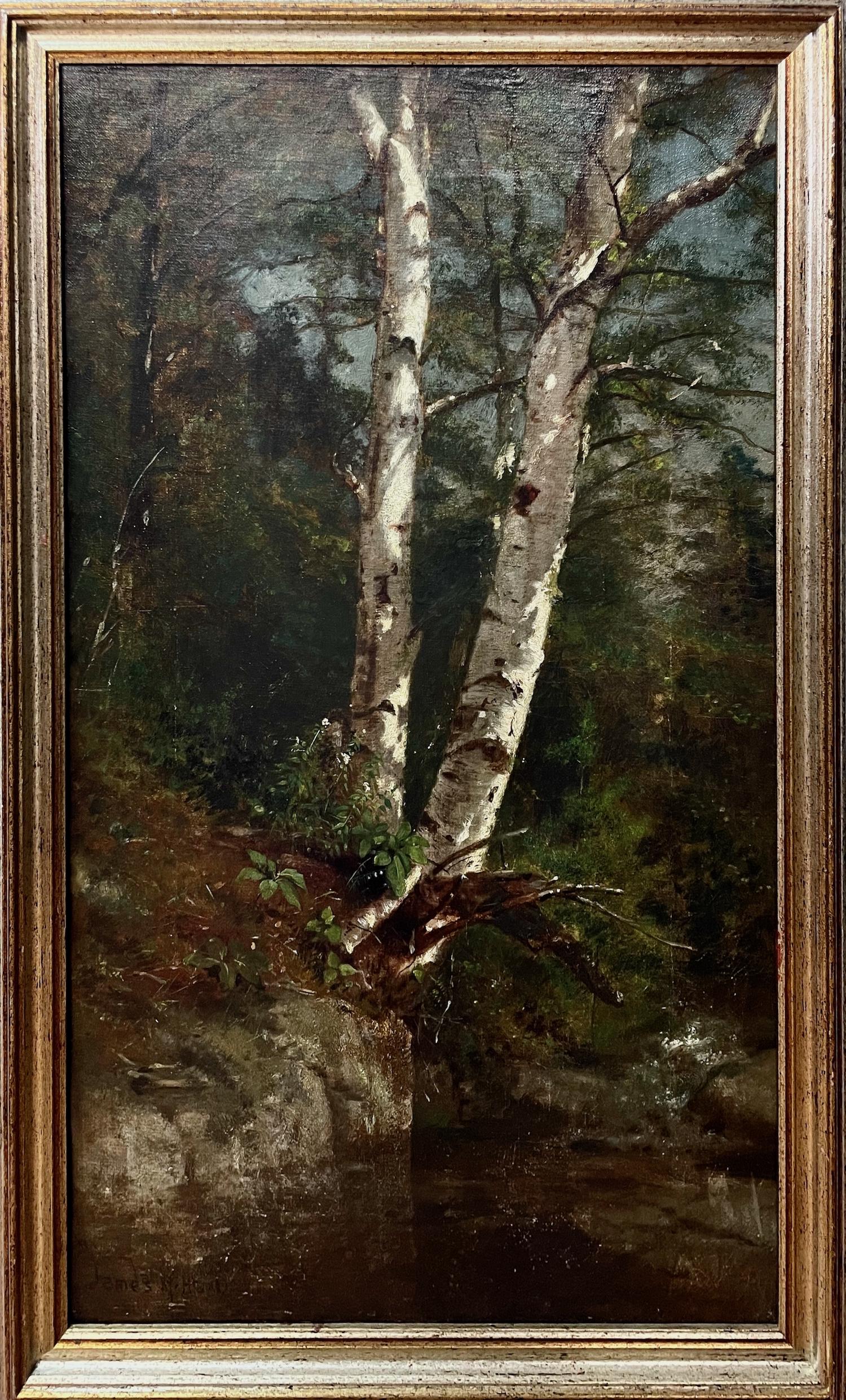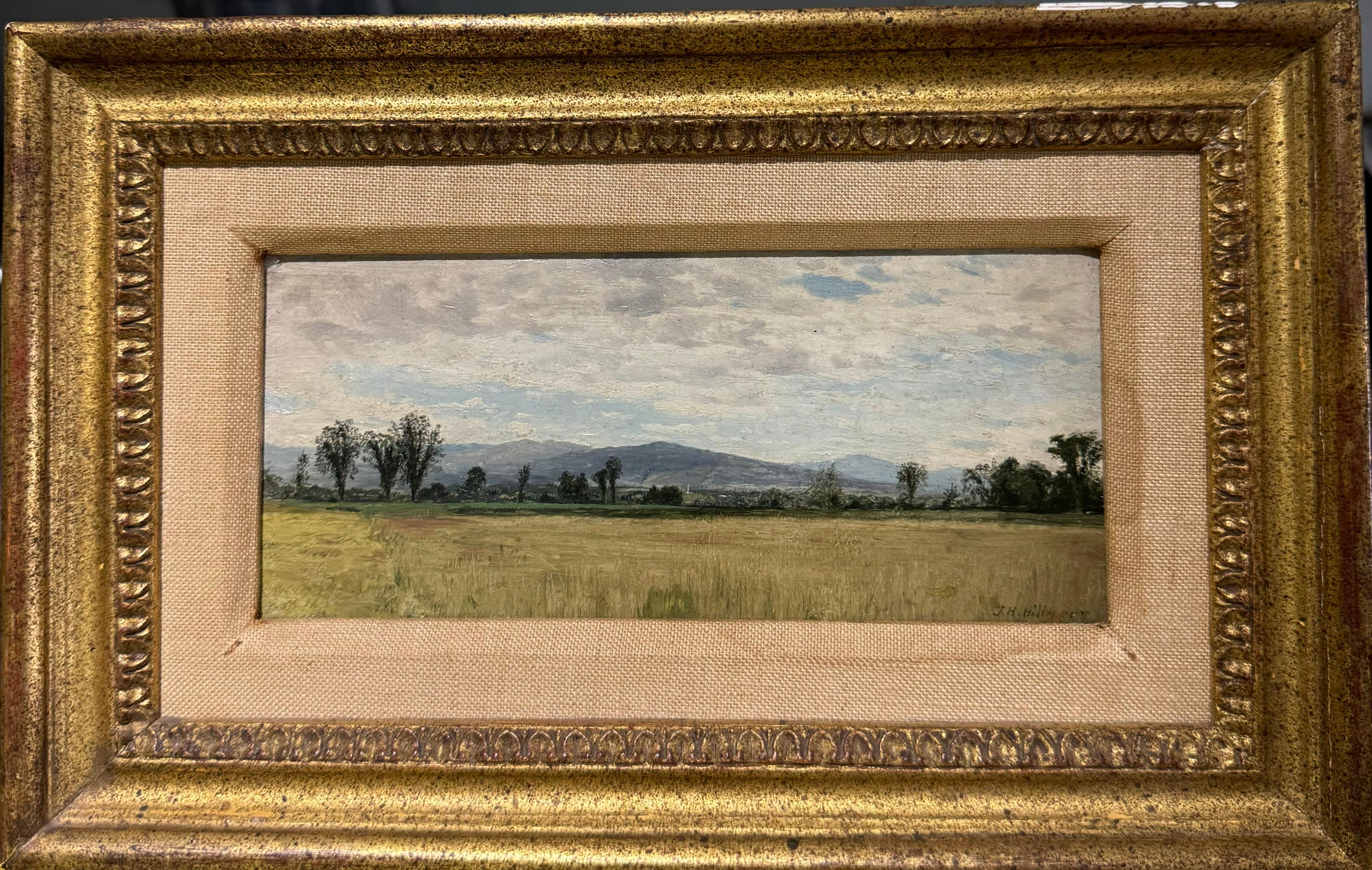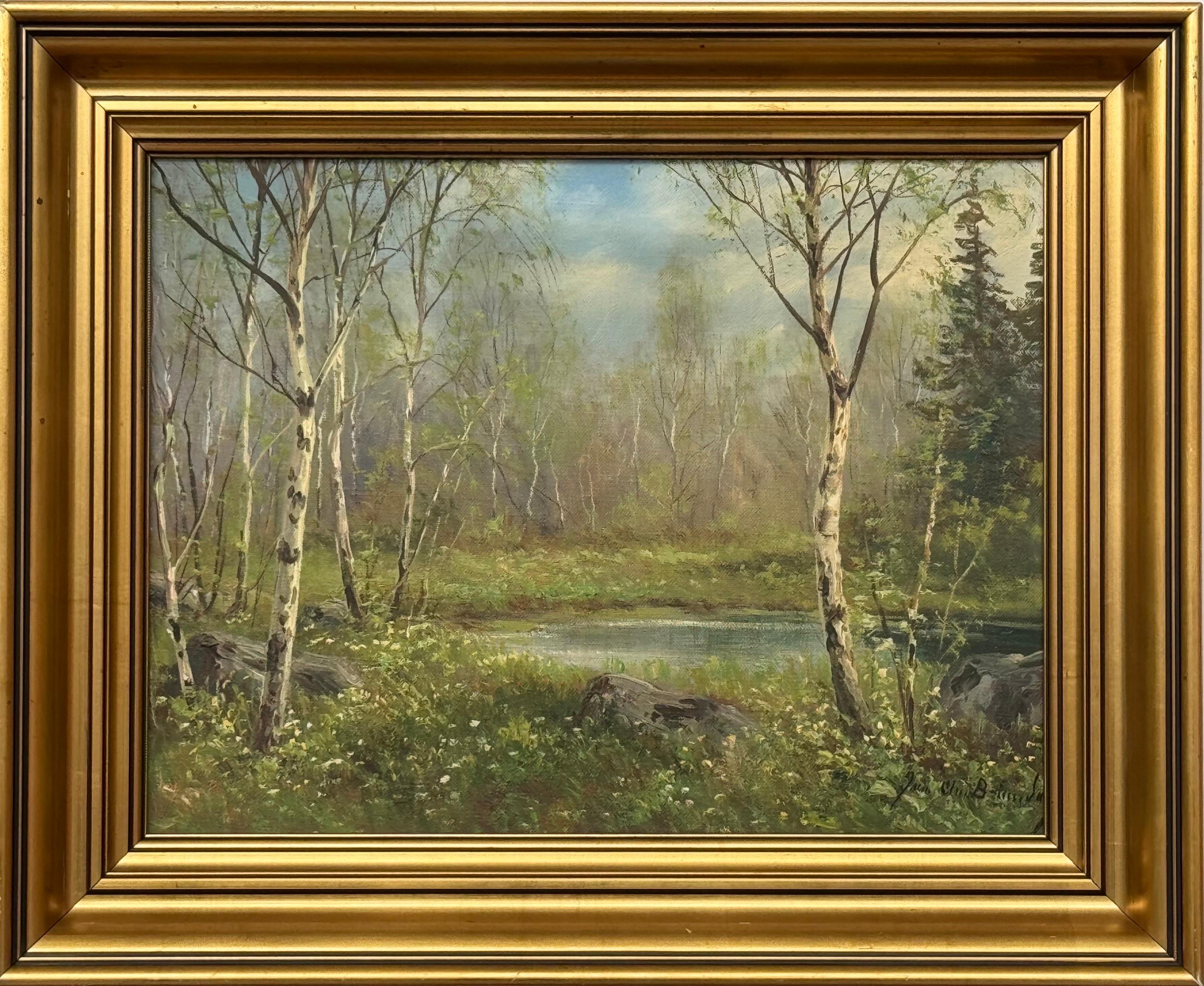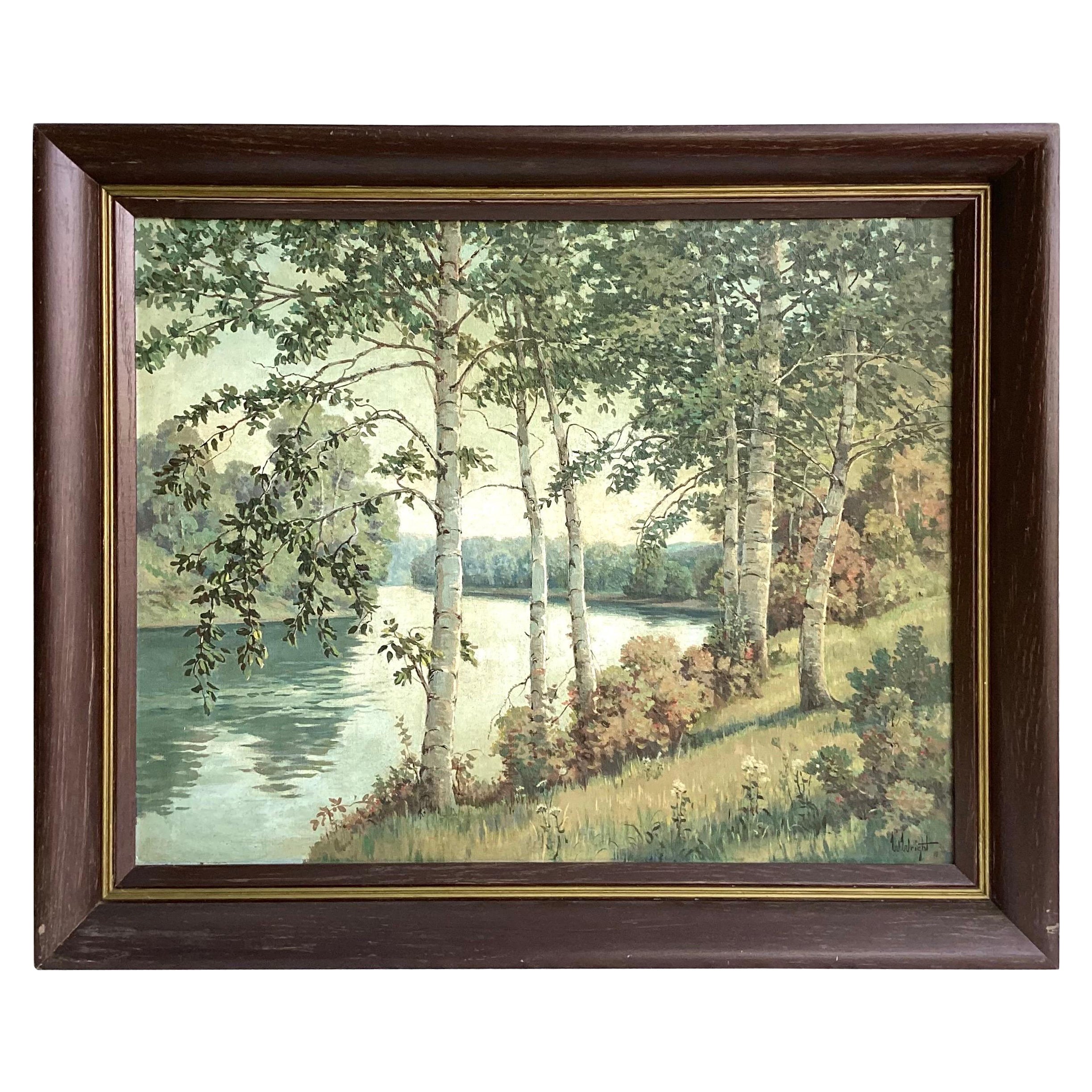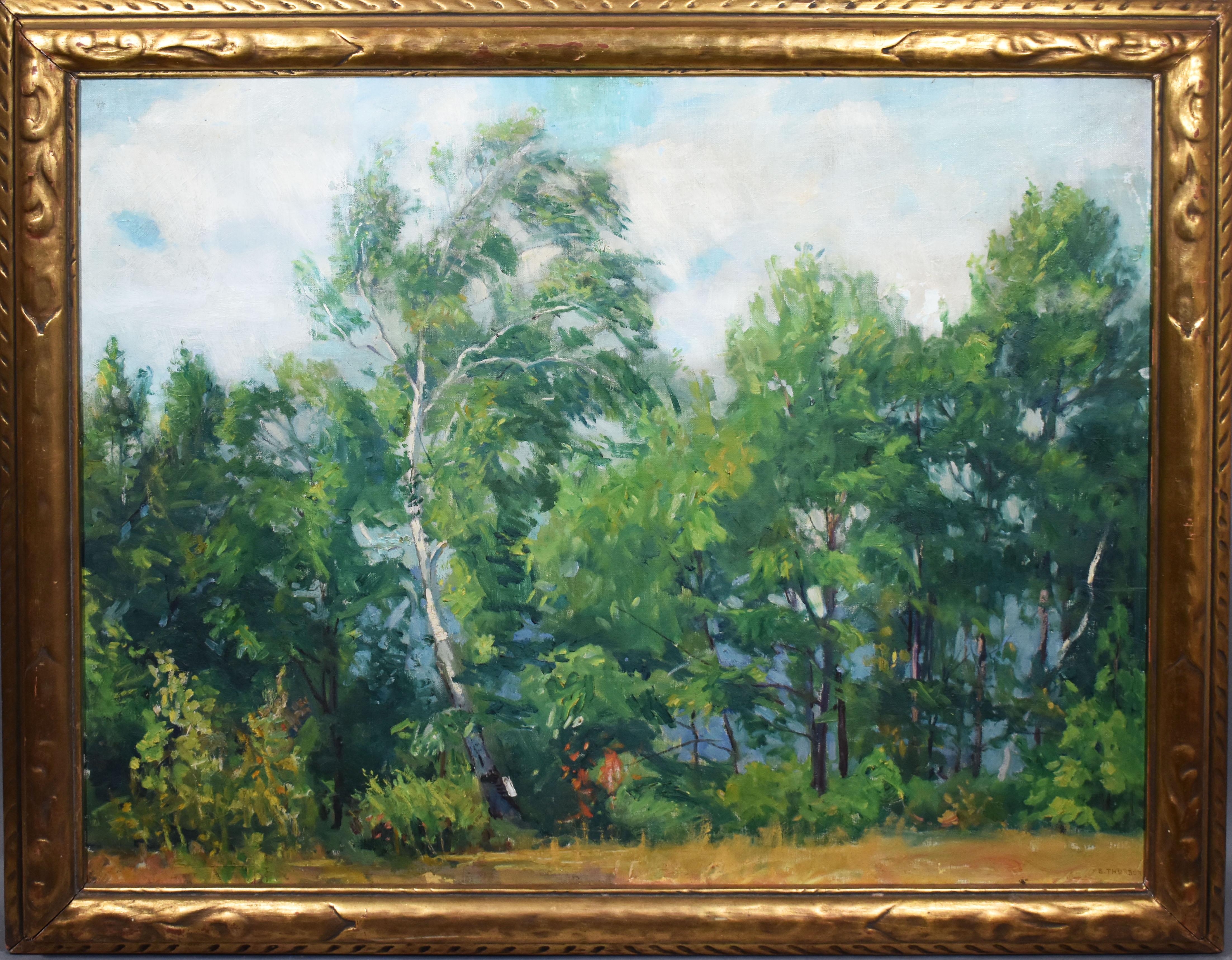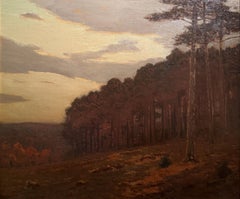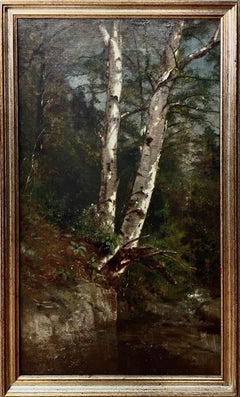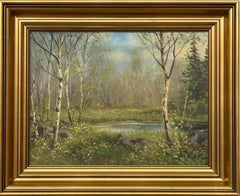Items Similar to "Birch Tree in Maine, " Hudson River School Antique Landscape, White Mountains
Want more images or videos?
Request additional images or videos from the seller
1 of 11
Harrison Bird Brown"Birch Tree in Maine, " Hudson River School Antique Landscape, White Mountains
$11,200
$14,00020% Off
£8,498.30
£10,622.8820% Off
€9,717.05
€12,146.3120% Off
CA$15,643.36
CA$19,554.2020% Off
A$17,393.29
A$21,741.6120% Off
CHF 9,081.82
CHF 11,352.2720% Off
MX$211,718.71
MX$264,648.3820% Off
NOK 115,880.03
NOK 144,850.0420% Off
SEK 108,574.05
SEK 135,717.5620% Off
DKK 72,520.12
DKK 90,650.1520% Off
Shipping
Retrieving quote...The 1stDibs Promise:
Authenticity Guarantee,
Money-Back Guarantee,
24-Hour Cancellation
About the Item
Harrison Bird Brown (1831 - 1915)
Birch Tree in Maine, New England, 19th Century
Oil on canvas
25 x 13 1/8 inches
Initialed lower left
Provenance:
Portland International Galleries, Maine
Mr. and Mrs. Walter M. Jeffords, Jr., Saratoga Springs, New York and Lexington, Kentucky (President of Brooklyn Borough Gas Company)
Private Collection, Chicago
Exhibited:
Portland Maine, Portland Museum of Art, 58 Maine Paintings 1820-1920: Selections from the Collection of Mr. and Mrs. Walter M. Jeffords, Jr., May 20 - June 20, 1976, cat. no. 11.
The above catalogue listing this vertical landscape will be included with your purchase.
"Mr. Brown has succeeded fully in accomplishing that which Mr. John Ruskin, in speaking of J. M. W. Turner's sea views, said no painter had yet accomplished; that is, the representation of the creamy foam which the storm lashes up from the waves along a rocky shore."
Harrison Bird Brown was born in 1831 in Portland, Maine, and is best known for his White Mountain landscapes and marine paintings of Maine's Casco Bay. By 1860, Brown was being praised as a leading American marine painter. Orphaned at age 15, he began an apprenticeship at age 21 with house and ship painters Forbes and Wilson. He then became a banner and sign painter, under the name "H. B. Brown, Banner & Ornamental, Painter".
Landscape painting was popular in the mid 19th century, thanks in part to the influence of Charles Codman (1800-1842), whose paintings were collected for their very romantic sentiments. Humanity versus nature, and the human relationship to nature, themes prevalent in mid and late-19th century literature and philosophy, figured frequently in his seascapes. He often painted in the White Mountains, and his name can be found in the guest registers of many places artists frequented in those mountains. The coast of Maine was also a favorite painting venue of Brown's for over thirty years. He depicted the wholesome outdoor environment of the state, with special fondness for the Casco Bay area, Monhegan, and Grand Manan, an island off the New Brunswick, Canada coast. Brown also produced two widely distributed illustrations of Crawford Notch for the Maine Central Railroad in 1890.
Harrison Bird Brown exhibited at the National Academy of Design in New York from 1858 to 1860, and at the Boston Athenaeum and Philadelphia Centennial Exposition in 1876. By 1892 he had become the best known native Maine painter of his time, and gained fame for himself and the state with a large canvas in the Maine pavilion of the 1893 World's Colombian Exposition in Chicago. In 1892 he was elected president of the Portland Society of Art.
That same year, however, he moved to London, England to be with his only surviving child, a daughter, and spent the last twenty-three years of his life there. He died in England in 1915, and his work has been preserved at the Peabody Museum in Salem, Massachusetts and at the Portland Museum of Art. Most of his paintings were completed in New England before he moved to London, but he continued to paint until his death in 1915.
Harrison Bird Brown's works can be seen at the Peabody Museum in Salem, Massachusetts and at the Portland Museum of Art. Henry Wadsworth Longfellow was known to have owned Brown's work.
The development of Maine's cultural and artistic history and heritage by Harrison Bird Brown set the stage for 20th century American Modernists, such as Andrew Wyeth, Marsden Hartley, and Rockwell Kent.
- Creator:Harrison Bird Brown (1831 - 1915, American)
- Dimensions:Height: 33 in (83.82 cm)Width: 21 in (53.34 cm)
- Medium:
- Movement & Style:
- Period:
- Condition:Excellent.
- Gallery Location:New York, NY
- Reference Number:1stDibs: LU184129919382
Harrison Bird Brown
Harrison Bird Brown was born in 1831 in Portland, Maine, and is best known for his White Mountain landscapes and marine paintings of Maine's Casco Bay. By 1860, Brown was being praised as a leading American marine painter. Known also as Harry B., Henry B., and some times mistakenly as Henry Box Brown (Eason), he began an apprenticeship at age 21 with house and ship painters Forbes and Wilson. He then became a banner and sign painter, under the name "H. B. Brown, Banner & Ornamental, Painter". Landscape painting was popular in the mid 19th century, thanks in part to the influence of Charles Codman (1800-1842), whose paintings were collected for their very romantic sentiments. It is possible that Brown saw examples of Codman's poetic paintings, and was influenced by his works. Brown was one of the early artists to paint the coastline of Maine's Monhegan Island, where he depicted the headlands as awesome, mystical forces. Humanity versus nature, and the human relationship to nature, themes prevalent in mid and late-19th century literature and philosophy, figured frequently in his seascapes. He often painted in the White Mountains, and his name can be found in the guest registers of many places artists frequented in those mountains. The coast of Maine was also a favorite painting venue of Brown's for over thirty years. He depicted the wholesome outdoor environment of the state, with special fondness for the Casco Bay area and Grand Manan, an island off the New Brunswick, Canada coast. Brown also produced two widely distributed illustrations of Crawford Notch for the Maine Central Railroad in 1890. Harrison Bird Brown exhibited at the National Academy of Design in New York from 1858 to 1860, and at the Boston Athenaeum and Philadelphia Centennial Exposition in 1876. By 1892 he had become the best known native Maine painter of his time, and gained fame for himself and the state with a large canvas in the Maine pavilion of the 1893 World's Colombian Exposition in Chicago. In 1892 he was elected president of the Portland Society of Art. That same year, however, he moved to England to be with his only surviving child, a daughter, and spent the last twenty-three years of his life there. He died in England in 1915, and his work has been preserved at the Peabody Museum in Salem, Massachusetts and at the Portland Museum of Art. Most of his paintings were completed in New England before he moved to London, but he continued to paint until his death in 1915. Harrison Bird Brown's works can be seen at the Peabody Museum in Salem, Massachusetts and at the Portland Museum of Art.
About the Seller
5.0
Platinum Seller
Premium sellers with a 4.7+ rating and 24-hour response times
Established in 2022
1stDibs seller since 2022
115 sales on 1stDibs
Typical response time: <1 hour
- ShippingRetrieving quote...Shipping from: New York, NY
- Return Policy
Authenticity Guarantee
In the unlikely event there’s an issue with an item’s authenticity, contact us within 1 year for a full refund. DetailsMoney-Back Guarantee
If your item is not as described, is damaged in transit, or does not arrive, contact us within 7 days for a full refund. Details24-Hour Cancellation
You have a 24-hour grace period in which to reconsider your purchase, with no questions asked.Vetted Professional Sellers
Our world-class sellers must adhere to strict standards for service and quality, maintaining the integrity of our listings.Price-Match Guarantee
If you find that a seller listed the same item for a lower price elsewhere, we’ll match it.Trusted Global Delivery
Our best-in-class carrier network provides specialized shipping options worldwide, including custom delivery.More From This Seller
View All"Grand Manan" Harrison Bird Brown, Maine Landscape, Hudson River School Seascape
By Harrison Bird Brown
Located in New York, NY
Harrison Bird Brown (1831 - 1915)
Grand Manan
Oil on canvas
12 x 20 inches
Signed with initials lower left
Harrison Bird Brown was born in 1831 in Portland, Maine, and is best known for his White Mountain landscapes and marine paintings of Maine's Casco Bay...
Category
Late 19th Century Hudson River School Landscape Paintings
Materials
Canvas, Oil
Rapelyea House, New York, William Rickarby Miller, Hudson River School Landscape
By William Rickarby Miller
Located in New York, NY
William Rickarby Miller
Rapelyea House, New York, 1884
Signed and dated lower left
Oil on canvas
20 x 30 inches
Provenance:
Kennedy Galleries, New York
Born in Staindrop, County Durham, England, he was a portrait and landscape painter, especially appreciated for watercolor painting, which he sold through the American Art Union...
Category
1880s Hudson River School Landscape Paintings
Materials
Canvas, Oil
"MacMahan's Maine, " Howard Everett Giles, Figurative Landscape, Impressionism
Located in New York, NY
Howard Everett Giles (1876 - 1955)
MacMahan's Maine
Oil on canvas backed with board
30 x 30 inches
Signed lower right
Provenance:
Art Institute of Chicago
Christie's New York, December 8, 2011, Lot 2
Howard Giles spent most of his career in New York City, where he was an educator, magazine illustrator, and painter who espoused the theory of Dynamic Symmetry. He was born in Brooklyn, and as a young man worked in a New York railroad office. Financial support of a family friend allowed him to study at the Art Students League with H. Siddons Mowbray. In early 1910, he became an illustrator for Scribner's Magazine, and in 1912, on sketching assignment for Scribner's went to England. During World War I, he did illustration for Harper's Monthly Magazine, and many of his images were 'roaring twenties' genre and figure paintings.
In 1912, he began teaching life classes at the New York School of Fine and Applied Arts (later Parsons School of Design), and remained there until the late 1920s. During that time, he was also a part-time instructor at the Childs-Walker School in Boston, and accepted numerous invitations to lecture including at Carnegie Institute in Pittsburgh, Pennsylvania Academy of the Fine Arts, Detroit Institute of Arts and Wellesley College.
His initial painting style was Impressionism, but he grew increasingly interested in other scientific, aesthetic theories. He worked with Jay Hambridge from 1916 to 1919, applying Hambridge's theory of Dynamic Symmetry to his painting and his lecture topics. From 1922 to 1926, Giles also worked with and was influenced in his own painting by colorist theorist Denman Ross, who espoused a limited and related color palette. For many of his paintings, Giles used watercolor although he also painted in oil and pastels.
During the last years before his retirement when he moved to Woodstock...
Category
Early 20th Century American Impressionist Landscape Paintings
Materials
Oil, Panel
"Autumn, New England" Charles Warren Eaton, Tonalist Gloaming Sunset in Woods
By Charles Warren Eaton
Located in New York, NY
Charles Warren Eaton
Autumn, New England
Signed lower right
Oil on canvas
30 x 36 inches
Provenance
Private Collection, Connecticut
A contemporary critic wrote that the paintings o...
Category
Early 1900s Tonalist Figurative Paintings
Materials
Canvas, Oil
"Sunset, Indian Summer" DeWitt Clinton Boutelle, Hudson River School Landscape
Located in New York, NY
DeWitt Clinton Boutelle
Sunset, Indian Summer, 1848-49
Signed and dated lower left
Oil on canvas
12 x 16 inches
DeWitt Clinton Boutelle was born in Troy, New York. He moved to Phil...
Category
1840s Hudson River School Figurative Paintings
Materials
Canvas, Oil
"Hubbard Park, Crescent City, Florida" George Frederick Morse, Landscape
Located in New York, NY
George Frederick Morse
Hubbard Park, Crescent City, Florida, 1906
Oil on canvas
17 x 12 inches
A landscape and marine painter from Portland, Maine, George Morse was a founding membe...
Category
Early 1900s Hudson River School Landscape Paintings
Materials
Canvas, Oil
$5,200 Sale Price
20% Off
You May Also Like
“Woodland Study”
Located in San Francisco, CA
Remarkably, this painting tells its own story on the verso. To save your eyesight, here's what it reveals: James McDougal Hart (1828-1901) Landscape, animal, and portrait painter.
A ...
Category
1860s Hudson River School Landscape Paintings
Materials
Canvas, Linen, Oil
Antique American Impressionist Birch Tree Landscape Framed 1940
Located in Douglas Manor, NY
#5-2899 Antique birch trees land scape, oil on artist board displayed in a wood frame.Signed lower left by Mori.Image size 9.5 H x 7.5 W
Category
1940s Landscape Paintings
Materials
Oil
1857 American Hudson River Rockland County Landscape Painting KENNEDY Gallery
By John Henry Hill
Located in New York, NY
John Henry Hill
1839-1922
Signed lower right
Dated: 1857
Sight size: 3 3/4 x 7 1/2 inches
Overall size: 7 3/4 x 11 1/2 inches
oil on panel
Good condition
Kennedy Gallery Label Verso
...
Category
1850s Hudson River School Landscape Paintings
Materials
Wood Panel
Forest Landscape in Scandinavia with Silver Birch Trees by Danish Artist
By Jens Christian Bennedsen
Located in Preston, GB
Forest Landscape in Scandinavia with Silver Birch Trees by Danish Artist, Jens Christian Bennedsen (1893-1967)
Art measures 12 x 10 inches
Frame measures 16 x 14 inches
This charm...
Category
Early 20th Century Realist Landscape Paintings
Materials
Canvas, Paint, Cotton Canvas, Oil
Canadian Birch Tree Landscape Painting Oil on Canvas Signed W. Wright, Framed
Located in Lambertville, NJ
Canadian Birch Tree Landscape Painting Oil on Canvas Signed W. Wright. Overall size 36 x 30 x 3 1/2 D image size 30“ x 24“. Great condition age-appropriate wear could stand a light c...
Category
Vintage 1950s Canadian Paintings
Materials
Canvas
Antique American Impressionist Tree Study Signed Rare Landscape Oil Painting
Located in Buffalo, NY
Antique American impressionist landscape painting by Edna Thurber (1887 - 1981). Oil on canvas, circa 1915. Signed. Displayed in a period impressionist ...
Category
Early 1900s Impressionist Landscape Paintings
Materials
Canvas, Oil
$2,316 Sale Price
20% Off
